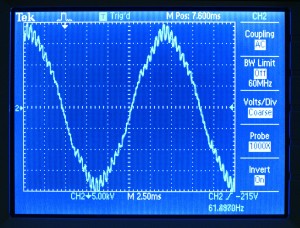Inverter Generators
Silence Is Golden — Inverter technology features quiet
operation and variable power.
 By Pam Meyer
By Pam Meyer
Silence is golden. Just ask anyone who has spent time working near a gasoline-powered conventional generator, as the steady sound of the engine can try one’s patience over the course of time.
Though appropriate on many job sites, the noise created by a conventional generator isn’t suitable for all applications or locations, such as densely populated neighborhoods that feature quiet zones.
Safety precautions like earplugs can help deaden the noise for operators, but sometimes they just aren’t feasible.
What happens in situations where a conventional generator may be too loud for the application at hand? Where does one look for a convenient power supply?
The answer lies in the innovative inverter generator technology.
Offered to consumers for many years, this equipment has been best known for operating at lower noise levels than its conventional counterparts. That’s not all, however. A myriad of other benefits is drawing the attention of both professionals and consumers alike.
Perhaps that’s why so many people are making “noise” about inverter generators.
QUIET OPERATION AND ADAPTABILITY
While inverter generator technology can seem a bit complicated, its benefits are key to end-users. The most common feature people associate with inverter generators is quiet operation. This comes as no surprise since inverter generators are typically the quietest operating generators on the market, thanks to several innovative features.
Inverter generators are specially engineered to dampen noise created by their mechanical operation. They are manufactured in a full sound-absorbing enclosure and offer large mufflers, designed to minimize noise. Any unenclosed engine, particularly one that is air-cooled, emits a great deal of mechanical noise.
Manufacturers have invested the design time and expense to enclose the air-cooled engine in such a way that minimizes noise while still allowing adequate air flow to properly cool the engine, electronics and exhaust system.
Another feature unique to inverter generators is the ability to vary engine speed depending on the draw of the equipment being plugged into them. For example, a conventional generator is required to operate at its full 3,600-rpm output regardless of whether it is powering one 60-watt light bulb or a furnace.
Unlike the conventional generator’s constant speed, the inverter generator adapts to the load to produce a more efficient, clean energy output.
The adaptability of inverter generators is created through an inverter module containing a microprocessor. The microprocessor reads the load, or amperage, of whatever is plugged into the generator. Depending on the load requirement, the microprocessor adjusts engine speed with an electronic governor. As the load increases, the engine automatically reacts by increasing rpm. Likewise, as the load decreases the engine decreases rpm.
The electronic governor feature on the inverter generator creates more precise engine reaction control than the mechanical governor found on conventional generators. Essentially, the reaction time is as fast as the signal can relay it.
The ability to adapt to changes in load offers several benefits beyond just a quieter running generator. Lower load demands require less engine power, naturally decreasing the already minimal mechanical noise created by inverter generators.
Adapting to the load also maximizes fuel efficiency and reduces wear on the engine components. Generally speaking, the adaptability improves inverter generator fuel efficiency by approximately 10 percent when compared with a similar-sized conventional generator, which equates to money saved at the fuel pump.
It should be noted that inverter generators offer the ability to override the engine speed variability. Disregarding the auto-power feature will cause the generator to run at a constant rpm in situations where it may be more beneficial, such as when fluctuation in draw is constant.
For example, a worker using an electric-powered nail gun may find it easier for the generator to run at a constant speed. Inverter generators can safely power electronic equipment by creating stable energy, since some devices are particularly sensitive to fluctuations in wave frequency.
HOW DO THEY WORK?
The most important words in the previous sentence are “wave frequency.” That is the entire key to what separates inverter generator technology from conventional
generators. The energy waves produced by inverter generators are “cleaner” than those produced by conventional generators. Here’s why:
 A conventional generator produces a single sine wave of AC power per full engine rotation. In order to create the standard 60 hertz needed to power equipment, the engine must maintain a constant speed of 3,600 rpm. No matter how much load is needed, the generator runs at its full speed of 3,600 rpm.
A conventional generator produces a single sine wave of AC power per full engine rotation. In order to create the standard 60 hertz needed to power equipment, the engine must maintain a constant speed of 3,600 rpm. No matter how much load is needed, the generator runs at its full speed of 3,600 rpm.
Inverter generators, however, produce more than 300 overlapping AC sine waves per engine rotation. As a  result, more electrical power is produced from each engine rotation. Before the inverter power can be used, it must first be transformed into the proper voltage and frequency required to power the user’s equipment.
result, more electrical power is produced from each engine rotation. Before the inverter power can be used, it must first be transformed into the proper voltage and frequency required to power the user’s equipment.
The inverter module “converts” three-phase, high-frequency AC power into DC
power, which is then “inverted” to a clean and stable 120 volt, 60 hertz AC power signal. This single, sophisticated electronic module controls all functions of both generator and engine.
The “pure” sine wave of energy produced by an inverter generator has full width and amplitude and no voltage surge. Comparing inverter and conventional generator sine waves clearly shows how clean the power really is when produced from an inverter generator. It’s this clean, stable output that makes the inverter generator ideal for sensitive electronic devices, such as laptops.
HANDLING OVERLOAD CAPACITY
It’s obvious to those with any prior generator experience that sensitive electronic devices are not the sole items tied to generator power. Equipment demanding extreme starting loads, such as air conditioners and air compressors, are just as common. Inverter technology is more than capable of handling these loads as well.
The innovations of the inverter module allow operation under an overload condition of up to 120 percent of the rated output for 20 seconds before the output is cut off. The inverter generator is well equipped to handle the stress caused through the initial start-up surge.
In order to handle the high overload surge and the potential heat issues created by enclosing the unit, inverter generators are built with electronic components that can handle a high heat load. An embedded temperature sensor monitors the electronic components of the inverter module. This thermal shut-off system determines if the temperature is too high or rising too quickly. If so, the microprocessor cuts output power while the engine continues to run, pulling air over the components to cool them. After several minutes the generator can be restarted to reset the thermal shut-off system.
Using high-grade components and a thermal shut-off system allows the inverter generator to be compatible even with commercial use. Some manufacturers include these critical electrical and inverter module components on their generators to ensure the equipment meets the demands of not only home and recreational applications but contractors and rental professionals as well.
A WIDE ARRAY OF USES
Not only are inverter generators appropriate for a wide range of applications, but the engineering and technology behind this equipment also create benefits that make them appropriate for a wide variety of users.
For example, those in the rental industry find its quiet operation especially popular for use through concession rentals, where the generator may be used at parties and special events. The reduced sound of the inverter allows attendees to focus on the gathering and not be distracted by equipment noise.
Camping and RV enthusiasts will also enjoy these quiet running generators. They can be used to power the luxuries of home in the great outdoors without interrupting others in the campground or on the trail.
Contractors find the inverter generator’s toughness an especially valuable feature. Larger models are constructed with exterior tubular steel frames and reinforced fuel tanks that can meet the extraordinary challenges of rough handling.
Regardless of application, all users appreciate its weight, or lack thereof. Inverter generators tend to be lighter than conventional counterparts due to their compact design, which makes them easier to carry around a job site or transport to a new location.
Considering the numerous benefits this equipment offers, it’s not surprising that inverter generators have grown in popularity over the last decade. The technology that defines inverters provides users with increased flexibility and more application options compared with conventional generators.
Add this to its quiet nature, and inverter generators can achieve status as the silent hero in any equipment fleet – from the largest commercial operation to the
smallest one-stall garage. CS
Pam Meyer is equipment sales manager for Subaru Robin. She can be reached at 800-277-6246; e-mail: pmeyer@robinamerica.com. Photos courtesy of Subaru.
















